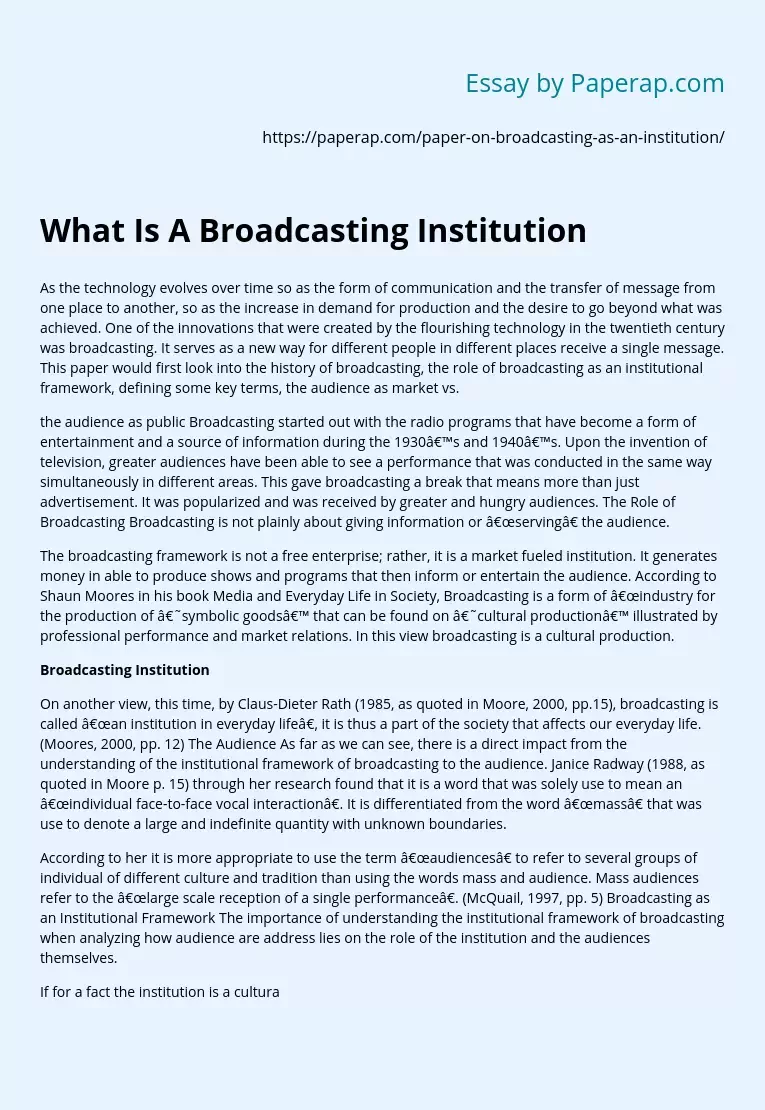What Is A Broadcasting Institution
As the technology evolves over time so as the form of communication and the transfer of message from one place to another, so as the increase in demand for production and the desire to go beyond what was achieved. One of the innovations that were created by the flourishing technology in the twentieth century was broadcasting. It serves as a new way for different people in different places receive a single message. This paper would first look into the history of broadcasting, the role of broadcasting as an institutional framework, defining some key terms, the audience as market vs.
the audience as public Broadcasting started out with the radio programs that have become a form of entertainment and a source of information during the 1930’s and 1940’s. Upon the invention of television, greater audiences have been able to see a performance that was conducted in the same way simultaneously in different areas. This gave broadcasting a break that means more than just advertisement.
It was popularized and was received by greater and hungry audiences. The Role of Broadcasting Broadcasting is not plainly about giving information or “serving” the audience.
The broadcasting framework is not a free enterprise; rather, it is a market fueled institution. It generates money in able to produce shows and programs that then inform or entertain the audience. According to Shaun Moores in his book Media and Everyday Life in Society, Broadcasting is a form of “industry for the production of ‘symbolic goods’ that can be found on ‘cultural production’ illustrated by professional performance and market relations.
In this view broadcasting is a cultural production.
Broadcasting Institution
On another view, this time, by Claus-Dieter Rath (1985, as quoted in Moore, 2000, pp.15), broadcasting is called “an institution in everyday life”, it is thus a part of the society that affects our everyday life. (Moores, 2000, pp. 12) The Audience As far as we can see, there is a direct impact from the understanding of the institutional framework of broadcasting to the audience. Janice Radway (1988, as quoted in Moore p. 15) through her research found that it is a word that was solely use to mean an “individual face-to-face vocal interaction”. It is differentiated from the word “mass” that was use to denote a large and indefinite quantity with unknown boundaries.
According to her it is more appropriate to use the term “audiences” to refer to several groups of individual of different culture and tradition than using the words mass and audience. Mass audiences refer to the “large scale reception of a single performance”. (McQuail, 1997, pp. 5) Broadcasting as an Institutional Framework The importance of understanding the institutional framework of broadcasting when analyzing how audience are address lies on the role of the institution and the audiences themselves.
If for a fact the institution is a cultural production, then we will find that it is all about, consumers, producers, manufacturers, in short, it is all about money-making and audiences are therefore seen as a market. On the other hand, if one would insist that broadcasting is actually a social everyday experience in which humans are bounded by common information and culture, then audiences are rendered as a public that has to be served.
According to Williams, (1991 as quoted in Ang, pp.28) the constitution of broadcast institutions is “paternal” in a sense that it has an ‘authoritarian system which has values and purposes maintained by its own use of power’. Having this in mind we are able to see the institution as a force that dictates cultural preferences. In this view the broadcasting network cater their programs to what the audiences have or ought to want. The audiences are treated as market or as consumers from which profit can be maximize through appealing to their taste.
What Is A Broadcasting Institution. (2019, Dec 05). Retrieved from https://paperap.com/paper-on-broadcasting-as-an-institution/

